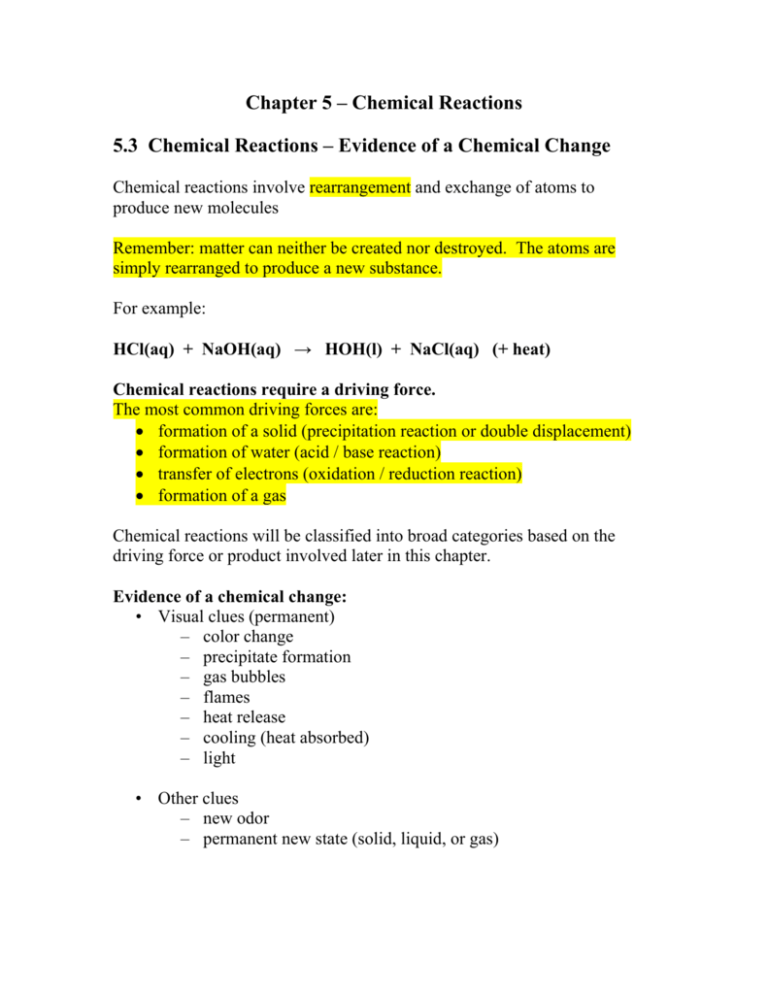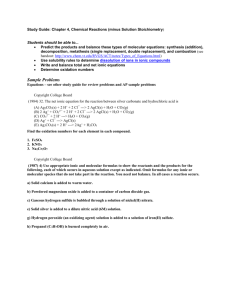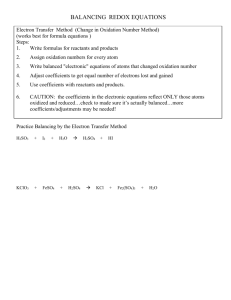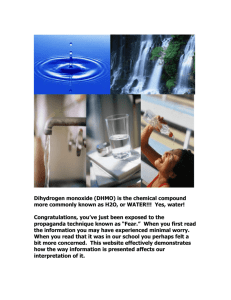
Chapter 5 – Chemical Reactions
5.3 Chemical Reactions – Evidence of a Chemical Change
Chemical reactions involve rearrangement and exchange of atoms to
produce new molecules
Remember: matter can neither be created nor destroyed. The atoms are
simply rearranged to produce a new substance.
For example:
HCl(aq) + NaOH(aq) → HOH(l) + NaCl(aq) (+ heat)
Chemical reactions require a driving force.
The most common driving forces are:
• formation of a solid (precipitation reaction or double displacement)
• formation of water (acid / base reaction)
• transfer of electrons (oxidation / reduction reaction)
• formation of a gas
Chemical reactions will be classified into broad categories based on the
driving force or product involved later in this chapter.
Evidence of a chemical change:
• Visual clues (permanent)
– color change
– precipitate formation
– gas bubbles
– flames
– heat release
– cooling (heat absorbed)
– light
• Other clues
– new odor
– permanent new state (solid, liquid, or gas)
Examples:
Nearly all chemical reactions involve some sort of transfer of energy,
sometimes in the form of heat.
Heat is produced: Methane + Oxygen:
Figure 6.3d:
Methane gas
reacts with
oxygen to
produce a
flame in a
bunsen
burner.
CH4(g) + O2(g) → CO2(g) + H2O(g) + heat + light
Heat is produced:
A hot pack used to warm hands and feet in winter. When the package is opened,
oxygen from the air penetrates a bag containing solid chemicals. The resulting
reaction produces heat for several hours.
Copyright © Houghton Mifflin Company.All rights reserved.
Heat is absorbed:
An injured girl
wearing a cold
pack to help
prevent
swelling. The
pack is
activated by
breaking an
ampule; this
initiates a
chemical
reaction that
absorbs heat
rapidly,
lowering the
temperature of
the area to
which the pack
is applied.
6–9
Gas is produced:
Figure 6.3c:
Bubbles of
hydrogen
gas form
when
calcium
metal reacts
with water.
Ca(s) + H2O(l) → H2(g) + Ca(OH)2(aq)
Gas and heat are produced
Sodium metal reacts with water containing a colorless dye, phenolphthalein.
The reaction generates heat and sodium hydroxide. The dye reacts with
hydroxide ion (OH-) to produce a pink colored compound.
• Na(s) + H2O(l) → H2(g) + NaOH(aq)
• OH- + phenolphthalein → pink color
Gas is produced:
Figure 6.1:
Bubbles of
hydrogen
and oxygen
gas form
when an
electric
current is
used to
decompose
water.
H2O(l) + e- → H2(g) + O2(g)
A solid (precipitate) forms:
Figure 6.3b:
A solid
forms when
a solution
of sodium
dichromate
is added to
a solution
of lead
nitrate.
Na2Cr2O7(aq) + Pb(NO3)2(aq) → PbCr2O7(s)↓ + NaNO3(aq)
5.4 Chemical Equations
• Shorthand way of describing a reaction
• Provide information about the reaction
– Qualitative Information:
• Formulas of reactants and products
• States of reactants and products (solid, liquid, gas)
– Quantitative Information:
• Relative numbers of reactant and product molecules that
are required
• Can be used to determine weights of reactants used and
of products that can be made (see Chapter 7: Chemical
Formula Relationships)
Writing a chemical equation
First: some symbols used in writing equations.
Begin with a “Word” equation:
Example: Methane gas burns to produce carbon dioxide gas and liquid
water:
(Note: whenever something burns it combines with O2(g), so O2 is a
reagent)
• Identify the reagents (what you start with) and the products (what you
end up with)
• Determine the chemical formula for each
• Reagents and reactants are separated by an arrow
• Reagents are written to the left of the arrow, and products to the right
of the arrow
The equation for this chemical reaction is:
CH4(g) + O2(g) → CO2(g) + H2O(l)
O
H
H
C
H
H
+
O
O
C
+
H
O
H
O
Writing a chemical equation: key points
1. Identify the elements or molecules involved in the reaction
– identify diatomic elements
– identify polyatomic ions
2. Write the equation as a word equation first, and then as a formula
3. Symbols are used after the chemical formula to indicate the state
– (g) = gas; (l) = liquid; (s) = solid
– (aq) = aqueous, dissolved in water
Example:
• Sodium reacts with water to produce hydrogen gas and sodium
hydroxide solution, and heat.
• Na + H2O → H2 + NaOH
• Na(s) + H2O(l) → H2(g) + NaOH(aq) + heat
Problem:
Zinc metal added to aqueous hydrogen chloride forms gaseous hydrogen and
zinc chloride.
Problem:
An aqueous solution of hydrogen fluoride reacts with silicon dioxide to form
gaseous silicon tetrafluoride plus liquid water.
Balancing Chemical Equations
Recall the following equation:
CH4(g) + O2(g) → CO2(g) + H2O(l)
O
H
H
C
H
H
+
O
O
C
+
H
O
H
O
Do you notice that something is wrong with the above equation, and also
some of the equations written earlier?
What’s wrong with this equation as written?
It’s only a qualitative expression of the chemical reaction.
This equation as written violates the law of conservation of matter. It must
be balanced so that the correct numbers of atoms are on each side of the
equation.
H
H
C
H
H
+
O
O
C
+
O
O
O
O
+
H
H
CH4 (g) + 2 O2 (g) → CO2 (g) + 2 H2O(l)
O
+
O
H
H
Now, this equation is both a qualitative and quantitative expression of this
chemical reaction.
Balancing a chemical equation: key points
The proper equation should be balanced
– obey Law of Conservation of Mass
– all elements found on reactants side are also on product side
– equal numbers of each element are on the reactant side as well as
on product side
Specific steps:
Balancing equations is a trial and error process. One approach:
• Start with the compound with the greatest number of elements
• Wait to balance uncombined elements (e.g. Na, O2, etc )
• Add coefficients in front of other compounds to balance the elements
in the starting compound
• Add coefficients in front of uncombined elements
• Clear any fractional coefficients by multiplying all coefficients by the
lowest common denominator
• Remove any “1” coefficients
• Double check the number of each element on both sides of the
equation
Don’t ……..
• Change a correct formula in order to make an element number balance
• Insert a coefficient within the correct formula to balance an element
Writing and balancing a chemical equation
Example: Magnesium metal burns to form a white powder, magnesium
oxide.
Note: Burning always means a reaction with oxygen (O2)
• Write out the chemical equation in words
• Identify the state of each chemical
magnesium(s) + oxygen(g) → magnesium oxide(s)
Write the equation as a formula with symbols of the elements
• identify diatomic elements
• identify polyatomic ions
• determine formulas
Mg(s) + O2(g) → MgO(s)
Employ coefficients to balance the number of elements on both sides of the
reaction arrow.
Mg(s) + O2(g) → MgO(s)
1
← Mg → 1
2← O → 1
• Multiply MgO by 2
• Then go back and multiply Mg by 2
• Verify that the number of each element are the same on both sides of
the equation
Example: Ammonia gas reacts with oxygen gas to produce gaseous
nitrogen monoxide and gaseous water
• Write the equation in words
• Identify the state of each chemical
ammonia(g) + oxygen(g) → nitrogen monoxide(g) + water(g)
Write the equation as a formula
– identify diatomic elements
– identify polyatomic ions
– determine formulas
NH3(g) + O2(g) → NO(g) + H2O(g)
Employ coefficients to balance the number of elements on both sides of the
reaction arrow.
All are balanced except H. Balance H by swapping the H subscripts and
making them coefficients.
2 NH3(g) + O2 (g) → NO(g) + 3 H2O(g)
Multiply NO by 2 to balance N
2 NH3(g) + O2 (g) → 2NO(g) + 3 H2O(g)
2x3
2
2
←H→
←N→2
←O→2
2x3
+
3
Now, O remains unbalanced.
– A trick of the trade, when you are forced to attack an element
that is in 3 or more compounds – find where it is uncombined.
You can find a factor to make an uncombined element any
amount you want, even if that factor is – temporarily – a
fraction!
– We want to make the O on the left equal 5, therefore we will
multiply it by 2.5
2 NH3(g) + 2.5 O2(g) →2 NO(g) + 3 H2O(g)
2 ← N →2
6←H→6
2.5 x 2 ← O → 2 + 3
Finally, multiply all the coefficients by a number to eliminate fractional
molecules.
4 NH3(g) + 5 O2 (g) →4 NO(g) + 6 H2O(g)
4 ← N →4
12 ← H → 12
10 ← O → 10
For practice, return to the “writing equations” examples above and balance
the equations.
For a tutorial on balancing equations, go to:
http://www.preparatorychemistry.com/Bishop_Balancing_Equations_frames
.htm
5.5 Writing Chemical Equations: Classification of Reactions
Reactions can be classified into several broad categories.
Note that categories frequently overlap, i.e. more than one classification can
apply.
Combination (Synthesis) Reactions
• Occurs when the number of products is fewer than the number of
reactants.
• The reactants are elements
• In symbolic form:
Example: the formation of water:
2 H2(g) + O2(g) → 2 H2O(l)
Note that in addition to classification as a combination or synthesis reaction,
this reaction can also be classified [as discussed below] as:
• Oxidation – reduction (because they involve oxygen or a transfer of
electrons)
• Combustion (because a flame is produced)
Problem:
Nitrogen gas plus oxygen gas react to form nitrogen oxide.
Write the balanced equation.
Decomposition Reactions
• The opposite of a combination reaction
• This occurs when the number of products is more than the number of
reactants.
• The compounds are broken down to simpler compounds, or all the
way down to the elements.
• In symbolic form:
Example: the decomposition of water
Example: the decomposition
2 H2O(l) → 2 H2(g) + O2(g)
PbO2(s) → Pb(s) + O2(g)
• Note that this is also an oxidation – reduction reaction: the Pb4+ and
O2- ions are changed from ions to the uncharged elements by the
transfer of electrons.
Problem:
Solid calcium carbonate decomposes into calcium oxide and carbon dioxide
gas. Write the balanced equation.
5.6 Single Replacement (or Single Displacement) OxidationReduction Reactions
All reactions that involve a transfer of one or more electrons are called
oxidation-reduction reactions. One type of oxidation-reduction reaction
involves a metal and a non-metal.
• The metal loses electrons and becomes a cation
• This process is called oxidation
• The nonmetal gains electrons and becomes an anion
• We call this process reduction
• In the reaction, electrons are transferred from the metal to the nonmetal
• One element replaces another element in a compound.
In symbolic form:
We say that the substance that loses electrons in the reaction is oxidized and
the substance that gains electrons in the reaction is reduced.
An acronym for remembering this is: OIL RIG
OIL – Oxidation is a Loss (of electrons)
RIG – Reduction is a Gain (of electrons)
Oxidation-reduction reactions can involve two metals. It may be
necessary to consult an “activity series” table to predict if a
reaction may take place. A metal listed above another metal in the
table will replace the metal below it
Example:
2Al + Fe2O3 → 2Fe + Al2O3
(Al oxidized → Al3+ , Fe3+ reduced → Fe)
This type of reaction is sometimes called a “redox” reaction.
Example:
Zn(s) + CuSO4(aq) → ZnSO4(aq) + Cu(s)
Example:
Na(s) + H2O(l) → H2(g) + NaOH(aq)
Example (also a synthesis reaction):
2Na + Cl2 → 2NaCl (Na oxidized → Na+ , Cl2 reduced → Cl- )
Problem:
Copper reacts with silver nitrate (assume copper(II) is formed). Write the
equation.
Note: Oxidation – reduction reactions will be discussed in greater detail in
Chapter 19.
Double Replacement (or Double Displacement): Precipitation
Reactions
• Two sets of ions in ionic compounds switch places in a reaction.
• If one of the products precipitates, this double displacement reaction is
known more specifically as a precipitation reaction
• If the reactants are an acid and a base, this double displacement reaction
is known as an acid-base reaction
• The general equation in symbolic form:
More accurately, representing the compounds as they exist in solution:
• AX(aq) + BY(aq) → AY(s) + BX(aq)
Either BX or AY may be insoluble and precipitate
Example:
2 NaCl(aq) + Pb(NO3)2(aq) →2 NaNO3(aq) + PbCl2(s)
Note: The reaction will not occur unless one of the products either
(1) precipitates, or
(2) is water
We can determine in advance whether a chemical reaction will proceed by
producing an insoluble product (precipitate). We do this be consulting a
table of solubility guidelines
Example:
HCl(aq) + NaOH(aq) → HOH(l) + NaCl(aq)
(+ heat)
Note: This double displacement is also classified as
• an acid – base reaction
• a synthesis reaction
Note: Double replacement precipitation reactions are discussed in greater
detail in Chapter 9 under Net Ionic Equations.
Acid – Base Reactions
When the reaction is between an acid (a compound that produces hydrogen
ions) and a base (any compound that forms hydroxide ions), water is formed
as one of the products. This specific type of double displacement reaction is
also called a Neutralization reaction.
General example: acid + base → water + ionic compound
Example: H2SO4(aq) + 2 NaOH(aq) → 2 H2O(l) + Na2SO4(aq)
Problem:
Write the balanced equation for the reaction of sulfuric acid and solid
aluminum hydroxide.
Note: Acid – base reactions will be discussed in greater detail in Chapter 17.
Combustion
Rapid reactions that involve oxygen and produce a flame or heat are called
combustion reactions. Typically, combustion occurs when a hydrocarbon
reacts with oxygen to produce carbon dioxide and water, and heat, usually in
the form of a flame. Hydrocarbons are a class of compounds that primarily
consist of hydrogen and carbon.
Example:
General example: CxHy + O2 → CO2 + H2O
Actual example:
2 C2H6 + 7 O2 → 4 CO2 + 6 H2O
This is also an oxidation – reduction reaction (see Chapter 9.6 and Chapter
19).
You should be familiar with the following common chemical reactions:
•
•
•
•
acid + base → water + ionic compound
metal + oxygen → ionic compound
metal + acid → hydrogen gas + ionic compound
ionic compound1 + ionic compound2 → ionic compound3 + ionic
compound4
• acid + carbonate → carbon dioxide + water + ionic compound
• metal1 + ionic compound1 → metal2 + ionic compound2
• hydrocarbon + oxygen → carbon dioxide + water
Exercise:
ClassificationTypesOfReactions – Ch5 web page exercise with answers









